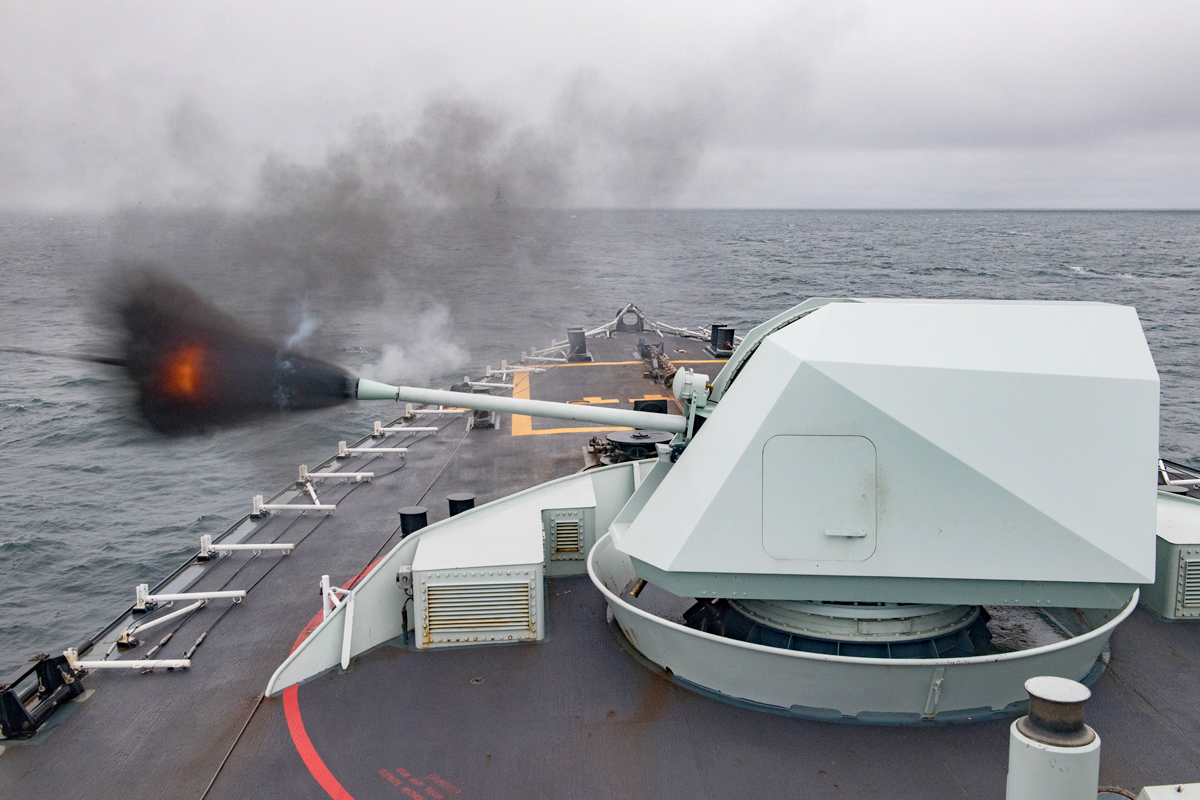Sea Training keeps HMCS Calgary busy
By Lookout Production on Apr 06, 2020 with Comments 0

HMCS Calgary conducts a surface firing exercise during the Directed Sea Readiness Training Program off the coast of Vancouver Island March 28. Photo by Corporal Jay Naples, MARPAC Imaging Services.
Lt(N) Greg Menzies, HMCS Calgary PAO ~
It was a loud, clear message that boomed throughout HMCS Calgary – a general alarm every sailor knows and trains to address.
“Emergency Stations, emergency stations: Fire, fire fire, fire in zone three golf in the machinery control room.”
As the alarm sounded, the crew knew what needed to be done – fight for their ship.
This time it was drill – an integral part of Calgary’s Directed Sea Readiness Training.
The training is a specifically tailored at-sea program designed to maintain a ship’s readiness state in the middle of its operational cycle. Using a focused training and evaluation plan, Directed Sea Readiness Training prepares the ship and crew to meet the operational requirements given by the Commander of Canadian Fleet Pacific.
Calgary’s road to high readiness started with the Basic Single Ship Readiness Training program after the ship completed several extended and short work periods last summer.
This training focused on seamanship, damage control, and safety. The training develops sailor’s skills to enable a ship to conduct ready duty ship, sea trials, force protection at sea and alongside, and the basic unit force generation necessary to move through a tiered readiness program administered by Sea Training (Pacific). They are the group that provides afloat and alongside collective training, certification, and maintenance of standards for ships and submarines through the continuum of readiness, assuring operationally capable sea power.
Upon completion of Basic Single Ship Readiness Training, Calgary progressed to Intermediate Multi-Ship Readiness Training in November operating within a task group environment. This training is designed to develop the ship’s capacity to fight within a multi-ship construct, providing the unit the ability to act as the ready duty combatant and deploy as part of a naval task group.
“Calgary is moving along nicely with its tiered readiness program and there is a strong and dedicated leadership at all levels on board,” said Commander Paul Francoeur, Commanding Officer of Sea Training (Pacific). “All training programs allow the command team and departments time to self-correct and apply lessons learned. Time is built into the program to give departments the opportunity to run self-directed training to improve on observations and prepare for upcoming event scenarios.”
The command team and all organizations within the ship (operations, combat systems engineering, marine systems engineering, deck, logistics and executive departments) are evaluated and coached through several planned scenarios such as damage control and firefighting, sustained events, emergency flying stations, man overboard, casualty evacuations, and harmful and inappropriate sexual behaviour management.
After each scenario, members from Sea Training staff begin a dialogue with every department to identify strengths and areas for improvement while providing the necessary guidance and mentorship.
Progress reports are built into each readiness program so Sea Training staff can debrief the ship’s command team and department heads on their progress. The Commanding Officer of Sea Training (Pacific) reviews the ship’s overall progress, since the previous progress meeting, allowing for open, honest, and actionable feedback. These progress reports give the leadership in Calgary the information needed to ensure the ship’s company is kept well informed of the ship’s progress and to make the necessary improvements required to be operationally ready at all levels.
After an exhaustive firefighting scenario in various locations within Calgary, “Secure emergency stations” was piped throughout the ship.
Calgary successfully completed another Directed Sea Readiness Training scenario and is one step closer to ensuring the Royal Canadian Navy retains an operationally capable sea power.
Filed Under: Top Stories
About the Author:





